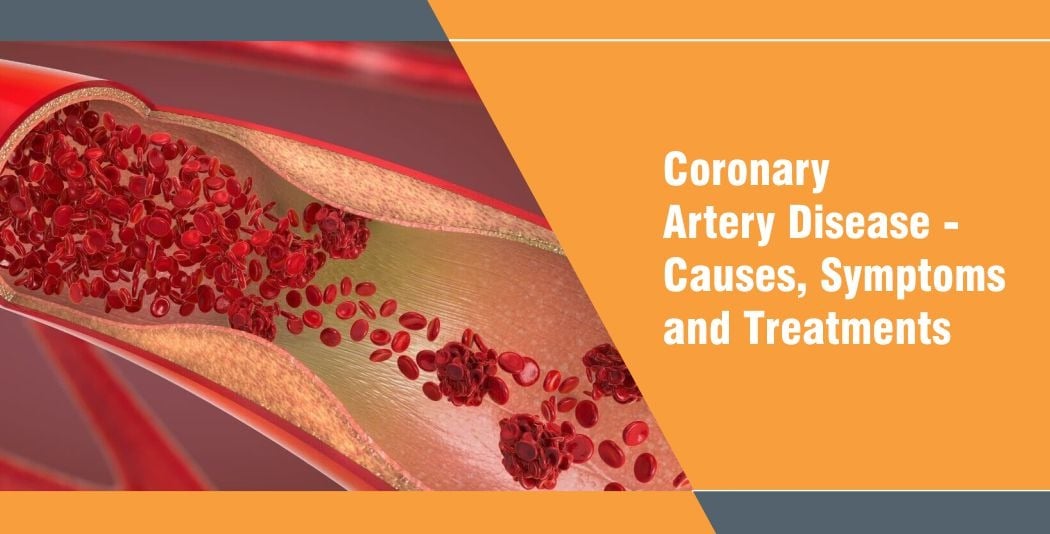Coronary Artery Disease – Causes, Symptoms and Treatments
June 17, 2020

What is Coronary Artery Disease?
The heart is a powerful muscular organ requiring adequate supply of oxygen to function efficiently. Oxygen- rich blood is carried to the heart through three arteries that branch into a network of smaller vessels.
Coronary Artery Disease affects the blood vessels (arteries) on the surface of the heart. These arteries bring blood (rich with oxygen and nutrients) to the heart.
Ageing and other complex factors cause these ordinarily soft and compliant blood vessels to harden. In addition, fat, cholesterol and minerals from the blood are deposited on the inner surface of the coronary arteries. When this material builds up, it forms a plaque that may restrict the blood flow through the coronary artery. Such plaque may also change the surface of the artery from smooth to rough, and these rough surfaces may stimulate the formation of a blood clot, which may slowly build up narrow the artery even more. A blood clot can also build up quickly and abruptly close off the artery.
What are the affects of Coronary Artery Disease?
Narrowed coronary arteries mean the amount of blood that reaches the heart muscle is reduced. Fatigue, tightness in the chest, or a peculiar crushing type of chest pain called angina pectoris may accompany the decreased blood flow. Such symptoms are caused by exercise and emotional stress, which cause the heart to require more blood. However, these symptoms can be handled with adequate rest.
If coronary artery suddenly closes, blood flow to a part of the heart may stop completely. In this case, some portion of the heart may be permanently damaged. This is often accompanied by severe chest pain that won’t disappear. This is called myocardial infraction, or more commonly, a heart attack. The heart can heal but the muscle is replaced by a scar tissue that doesn’t contract. If the scar is small, recovery can be complete. If the scar is large it may permanently affect the pumping ability of the heart. It is therefore important that blood supply to the heart be restored before a Heart Attack can occur.
How is Coronary Artery Disease Diagnosed?
A Coronary Angiogram shows where the arteries are narrowed or blocked
If you have an increased risk of Coronary Artery Disease or certain symptoms of the disease, your doctor may recommend a Stress test, exercise or electrocardiogram (ECG). The Stress test measures changes in the electrical activity of your heart while you perform controlled exercise. This test can show if there has been damage to your heart.
If the results of the stress test indicate a need for further testing, your doctor may arrange for you to have a Coronary Angiogram, also called Cardiac Catheterization. The coronary angiogram is the most useful test for diagnosing CAD because it allows the doctor to see exactly where the coronary arteries are narrowed or blocked.
Before conducting the angiogram, you will be administered a local anesthetic or pain medicine. The doctor then inserts an introducer sheath into an artery in your groin or through an incision in your arm. Then the doctor insets a long tube called guiding catheter, into the artery and advances into the blocked artery. By injecting a contrast dye that can be seen on an X-ray screen, the doctor can observe the arteries in your heart. You may be asked to take a deep breath and hold it while the doctor is conducting the angiogram. Any narrowing or blockage that exists can then be identified. In some cases, the doctor performs a primary angioplasty, or balloon procedure, immediately following the angiogram in order to open the coronary artery for blood flow.
What can be done to relieve blockage in the Coronary Arteries?
Plaques that block the coronary arteries usually occur in localised portions of the arteries. The part of the artery beyond the narrowing or closure is often not blocked. When the disease is localised in one or two arteries, the blocked can sometimes be opened by stretching or dilating. This is done by using a small balloon on a tube inside the artery. This procedure is called Angioplasty or PTCA (Precutaneous Transluminal Coronary Angioplasty).
Angioplasty has become a relatively common procedure in recent years. Patients around the world will testify to its success in their lives. That said, it still has few risks attached.
Your doctor will discuss the risks that specifically relate to your condition.
How is Angioplasty performed?
Patients who have undergone an Angiogram will find. Angioplasty procedure almost simila. Angioplasty is also performed in a Cardiac Cath lab, patients usually receive medication before and during angioplasty procedure to help them relax. You are awake and alert throughout the procedure and are required to respond to the doctors requests during the procedure.
Angioplasty begins by inserting a sheath for the catheter into a blood vessel, most often in the upper leg or groin area, but sometimes in the arm.
A very small balloon catheter is passed through the sheath and into the blood vessel leading to the coronary arteries.
With the help of the X-ray, the Cardiologist follows the path of the catheter on the fluoroscope. Pictures may be taken just like in an angiogram.
Once the balloon is at the narrowing of the artery, the balloon is centered, it is then inflated to open the blockage.
While every situation is unique, inflation in most cases will last from 30 seconds to several minutes, depending on the nature of the blockage. The balloon is inflated at least two times. However, it may also be inflated to ten or more times.
While the balloon is inflated, some people experience chest pain that is similar to the angina they have experienced. This happens because the balloon temporarily blocks off the flowof blood and the oxygen that it carries to the heart. Patients should report any pain they feel during the procedure to the Doctor. After the block is opened, the balloon is deflated and retracted back through the blood vessel.
Can Angioplasty be performed in other Arteries?
Balloon Angioplasty has expanded the scope of treatment from patients of Coronary Artery Disease to those suffering from blockages in the other arteries of the body. The procedure is being increasingly used to open blockages in the Carotid artery, Renal artery and other Peripheral arteries.
What is a Stent?
A stent is an expandable mesh tube of a special metal which is designed into a cylindrical wave pattern. The shape and material of the stent offer flexibility for a balloon to adapt to the shape and curves of the artery.
A Stent is implanted to support the artery and keep the vessel open like a structural frame work. It is introduced into your artery just after balloon Angioplasty and is positioned at the site of the obstruction. Implantation of a stent benefits those patients who have a potential for future problems such as block recurrence or restenosis. The stent is implanted permanently in the artery.
What is Percutaneous Transluminal Rotational Ablation (PTCRA)?
One of the treatment options of Coronary Artery Stenosis is the PTCRA or Rotablator System that is used as a stand alone treatment or in conjunction with PTCA.
The Rotablator system is a cather-based Angioplasty device utilizing a diamond-coated elliptical burr at the tip of a flexible drive shaft. Tracking coaxially over a guide wire and rotating at upon 190,000 revolutions per minute, the burr preferentially cuts away plaque while avoiding healthy tissue. The burr ablates plaque into fine particles that are disposed off by the body’s reticuloendothelial system.
What happens after the Angioplasty Procedure?
After the Angioplosty procedure, patents are taken to an Intensive care unit with special monitoring equipment. Blood pressure, pulse monitoring and ECGs performed routinely after Angioplasty procedures and do not signify any special problems. If a patient experiences any chest discomfort or pressure. the nurse should be notified immediately.
Recovery in the hospital is most likely a matter of allowing the insertion site to heal before getting up and walking around. Most patients are required held their leg or arm straight and still for the first six to eight hours. You may be required to stay in the Hospital for 3-5 days before being discharged to the care of your family doctor. You can resume full activity within a few days of returning home.
Angioplasty is not a cure, but a treatment to reduce the affects of Coronary Artery Disease. It is extremely important to follow your medication regimen without deviation. Another element for quick recovery involve.es accommodating lifestyle changes to improve their health and minimize to the impact of their heart disease. Several factors are known to contribute to the buildup of plaque in the coronary arteries. It is the combination of several of these risk factors, rather than a single factor, that impacts coronary artery disease.
Some of these risk factors such as male sex, age and heredity can only be attended but cannot be changed. However, other factors that can be controlled include:
* High Blood Pressure* Smoking* High Blood Cholesterol* Body Weight* Diabetes* Lack of Proper Exercise* Stress








